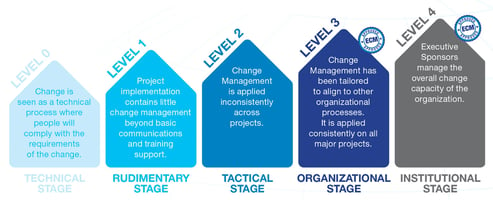By David Miller, CEO, Changefirst

On Friday 19th June, I led a round table discussion at the APMG Showcase in London. The discussion was all about Enterprise Change Management (ECM) and how it can benefit organisations. Because this session was focused on Program and Project Managers (P&PM's), it made me think about what the true relevance is, of building ECM for them specifically.
We believe that the lack of ECM capabilities in an organisation leads to significant challenges for P&PM’s and consequently a lot of changes are only delivered rather than having achieved the benefits realisation.
Solution delivered means that the change has been put into place but the people have not changed their behaviours and ways of working significantly enough for the organisation to achieve the benefits realisation it has forecast. This creates a ‘value gap’ which is often the mandate for having effective change management processes in place on any program or project. The cost of benefits realisation is different for each organisation but we would estimate that over 70% of projects in all organisations only achieve solution delivery rather than benefits realisation.
Either because of this gap or as a result of it - many organisations are reporting that there is a significant gap between the need for a change program to be executed and the capabilities of the organisation to deliver it. There have been a number of studies that have substantiated this over the years. The problem seems to be getting worse as markets become more disruptive and even long established industries are facing environmental, social and economic threats and opportunities.
In this week’s Fortune magazine they are reporting that the top 25 food and beverage companies in the US have lost $18bn of market value because of significant changes in people’s eating habits. These types of changes are causing the pace of change to accelerate and as a result, promoting a great deal of discussion about what makes organisations more agile.
Our view is that there are many factors which make an organisation agile. But if we narrow it down to our specific area of expertise we know that successful, agile organisations are far more likely to have a standardised change management process which is used by the majority of employees.
Our change management maturity model seeks to explain how organisations build the required change management capabilities over a period of time
The Change Management Maturity Model
Our paper, “Enterprise Change Management - Making Change Your Business” describes the stages of change maturity in significantly more detail. In particular, it sets out indicative standards that need to be achieved if an organisation is to reach change maturity.
It is extremely hard for organisations to move beyond Level 2 and for P&PMs to consistently deliver projects, without a considerable additional amount of capability building. In this environment each P&PM is constantly faced with user groups who don’t understand change management and more significantly, are unaware of their role in achieving implementation. This puts P&PM’s in a position of not only being an advocate for the project but also making the case for using effective implementation techniques. Sometimes this works and sometimes it doesn’t, however more often than not it can lead to extremely patchy implementation.
Additionally, P&PM’s at Level 2 are working in organisations where the environment is not uniformly conducive to using a set of standard processes which is also extremely time-consuming and wasteful.
Unfortunately, most P&PM’s cannot influence the organisation significantly enough to help it build ECM capabilities as they rarely have enough positional power or influence to achieve that. That is not to say that a CIO or Head of Business Change cannot advocate for the critical business necessity of building ECM capabilities. Given this scenario, a P&PM may be able to use tactics to help mitigate some of the effects of low maturity in ECM. Three suggestions to operate more successfully in this environment are:
1. Build high levels of sponsorship in user departments. Go beyond what you would normally do and engage executives and executives in user departments in discussions and planning of the change management components of implementation.
2. Use every user briefing and workshop as a way of educating user groups in change management. There is no need to tell people they are being educated in change management but you can run engaging sessions, utilising data, which help people understand the change management issues and potential remedies.
3. Use change management diagnostics and tools to help user groups understand the impact on them, the readiness the change and to roadmap the program of work. You may need to do this more subliminally than you would normally do and with more care. But it is possible to work below the radar.




Leave a comment